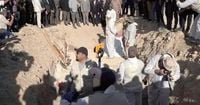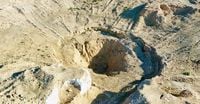On the outskirts of Mosul, a city that once stood as the capital of the Islamic State’s (IS) self-declared caliphate, a team of Iraqi officials, forensic experts, and grieving families have begun an arduous process: excavating the infamous al-Khasfa mass grave. The site, a yawning sinkhole roughly 150 meters deep and 110 meters wide, is believed to be one of the world’s largest repositories of human remains from the IS era—a grim testament to the group’s reign of terror between 2014 and 2017.
Excavation efforts at al-Khasfa began in early August 2025, following years of appeals from families and rights groups for answers. The operation kicked off on August 9 at the request of Nineveh Governor Abdulqader al-Dakhil, with surface-level digging commencing the following day. By August 17, an AFP correspondent reported that human skulls were already being unearthed from the sand, a stark reminder of the horrors that unfolded here less than a decade ago (as reported by France 24 and AFP).
Al-Khasfa, located about 20 kilometers south of Mosul, served as a killing ground during IS’s brutal grip on the region. According to the Iraqi News Agency, the excavation is a coordinated effort involving local authorities, the judiciary, forensic investigators, Iraq’s Martyrs’ Foundation, and the directorate of mass graves. The initial phase focuses on collecting visible human remains and gathering surface evidence, with full-scale exhumation to follow—an undertaking officials say will require international support due to the site’s complexity and hazards.
“A very complicated site,” is how Ahmad Qusay al-Asady, head of the Martyrs Foundation’s mass graves excavation department, described al-Khasfa to the Associated Press. The presence of underground sulfur water has made the earth porous, complicating both the excavation and the preservation of remains. This water may have eroded bones, making DNA identification a daunting task. In addition, unexploded ordnance left behind from battles with IS further endangers workers at the site.
Despite the peril, the mission is essential. Official estimates suggest at least 4,000 bodies are buried at al-Khasfa, though some reports indicate the number could be much higher. A 2018 United Nations report flagged Khasfa as likely Iraq’s largest mass grave, and the site is often referred to by lawyers and investigators as “the largest mass grave in modern Iraqi history” (according to lawyer Rabah Nouri Attiyah, as cited by the Associated Press). However, al-Asady maintains a more measured stance: “We cannot confirm yet if it is the largest mass grave to be found in Iraq, but according to the size of the space, we estimate it to be one of the largest.”
The victims at al-Khasfa are believed to represent a cross-section of Iraqi society. Approximately 70% of the remains are thought to be those of Iraqi army and police personnel, many of whom were executed after being transported to the site by IS fighters, often by bus. Other victims include members of the Yazidi minority, a religious group that suffered immensely under IS rule, as well as local residents of Mosul and surrounding regions. Witness accounts and testimonies suggest that many of the victims were decapitated—a chilling detail that underscores the brutality of the executions (as reported by the Associated Press and corroborated by multiple sources).
One particularly horrific episode stands out: in 2016, IS militants executed 280 people at the site in a single day, many of them employees of the interior ministry. The massacre at al-Khasfa is emblematic of the group’s broader campaign of terror, which saw it seize large swathes of Iraq and Syria, enforce a draconian interpretation of Islamic law, and commit widespread atrocities. At its peak, IS ruled an area half the size of the United Kingdom, leaving behind more than 200 mass graves in Iraq alone, potentially containing up to 12,000 bodies according to United Nations estimates (as reported by France 24 and AFP).
The excavation is not only a technical challenge but also a deeply emotional endeavor. For many, like lawyer Rabah Nouri Attiyah—whose uncle and cousin, both police officers, were killed by IS—the hope of identifying and recovering loved ones is a driving force. After the initial 15 days of surface work, the Martyrs’ Foundation plans to build a database and begin collecting DNA samples from families of suspected victims. This painstaking process is seen as a crucial step toward providing closure for thousands of families across Iraq.
Pressure for action has been mounting for years. Despite Mosul’s liberation in July 2017, al-Khasfa remained sealed until the recent excavation efforts. The site’s reopening has been welcomed by families and rights organizations, who have long demanded urgent measures to reveal the full scale of IS’s crimes and provide answers to the relatives of the missing (as highlighted by Shafaq News and other local outlets).
The Iraqi government has pledged its full support for the investigation. On August 18, government spokesperson Bassem al-Awadi affirmed Baghdad’s commitment to backing legal and technical measures to identify victims, aid families, and secure international recognition of the crimes committed by IS. “New evidence of ISIS crimes continues to emerge years after the group’s defeat,” al-Awadi said in a statement, emphasizing the government’s resolve to see justice done (as reported by Shafaq News).
As the excavation proceeds, the scale of the tragedy becomes ever more apparent. The process is slow and fraught with difficulty, requiring not only technical expertise but also international cooperation and resources. The hope is that, with time, the painstaking work at al-Khasfa will bring long-awaited answers to thousands of families and serve as a lasting testament to the resilience of a nation scarred by conflict.
Beyond the IS era, Iraq continues to unearth mass graves dating back to the rule of Saddam Hussein, who was toppled in a US-led invasion in 2003. The country’s landscape is thus marked by layers of trauma, each excavation a step toward reckoning with a painful past and building a future grounded in truth and accountability.
For now, the eyes of Iraq—and the world—remain fixed on al-Khasfa, where the sands of northern Iraq are finally yielding their secrets, one painstaking handful at a time.


